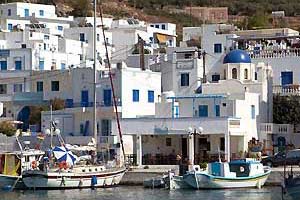 The island of Amorgos is the most easterly of the Cyclades and the
nearest to the Dodecanese. With an approximate population of 1800,
the coastline stretches for 121 kilometres while the total land mass
is 121 square kilometres. Amorgos is the seventh largest island in
the Cyclades and has 2 ports, Katapola at its centre and Aigiali in
the north.
The island of Amorgos is the most easterly of the Cyclades and the
nearest to the Dodecanese. With an approximate population of 1800,
the coastline stretches for 121 kilometres while the total land mass
is 121 square kilometres. Amorgos is the seventh largest island in
the Cyclades and has 2 ports, Katapola at its centre and Aigiali in
the north.
The 136 mile journey from Piraeus to Amorgos takes between 7 - 9 hours by regular ferry or 4 - 5 hours by highspeed ferry. There are regular ferry connections with the islands of Paros, Naxos and Mykonos and less frequent connections with most of the other Cycladic islands.
Amorgos has been inhabited since prehistoric times, with finds
discovered from the early Cycladic period. The presence of Cretans
from the Minoan period has also been established and thoughts are
that Amorgos formed one of the residences of King Minos himself. In
later years, having fallen under the occupancy of the Romans,
Venetians and Turks, the subsequent architecture of Amorgos is rich
and diverse and when combined with fine beaches, wild landscapes,
beautiful churches and ancient sites, visitors to Amorgos can enjoy
the relaxing way of life in very traditional and picturesque
environments displaying an original character and amazing beauty.
THE TOWNS AND VILLAGES OF AMORGOS
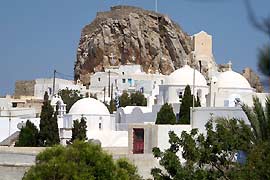
Amorgos (Chora).
The capital, Chora can be found in the centre of the island of
Amorgos, 400 metres above sea level. This charming medieval town
lies hidden behind the mountains and is topped by a 13th century
Venetian castle.
Surrounded by wonderful windmills, the Cycladic architecture, the Byzantine and early Christian churches, the narrow paved paths and whitewashed houses with flower pots, all unite to give a unique colour and atmosphere to Chora.
The delightful main square of Chora, Plateia Loza, is surrounded by little coffee shops and is a most pleasant spot to enjoy some relaxation.
Katapola.
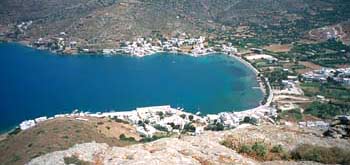 At the centre of Amorgos, Katapola is actually comprised of 3
villages, Katapola, Rahidi and Xilokeratidi, forming the main port
of the island and one of the best natural harbours in the Cyclades.
At the centre of Amorgos, Katapola is actually comprised of 3
villages, Katapola, Rahidi and Xilokeratidi, forming the main port
of the island and one of the best natural harbours in the Cyclades.
Built on the slopes of hills, Katapola overlook the sheltered bay. Above the town is the ancient settlement of Minoa with visible remains of the gymnasium, stadium and a temple of Apollo.
The picturesque landscape and the simple Cycladic architecture of the settlements are interesting to see, together with the monument to Panagia Katapoliani, and the Byzantine church of Evagelismos above Xilokeratidi.
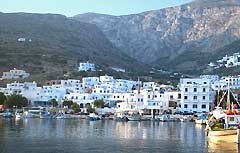 Aegiali.
Aegiali.
Located at the northern tip of Amorgos, Aegiali is the islands'
second and smaller port with the traditional villages of Tholaria,
Lagada and Potamos all being incorporated. Despite being the most
touristic town on Amorgos, the area has extraordinary natural
scenery featuring the ruins of towers from the Hellenistic period.
Of particular interest are the Byzantine monuments of Panagia Theoskepasti and Ioannis Chrisostomos plus the abandoned settlements of Oxo Meria and Asfontili
Kato Meria
One of the most beautiful areas of Amorgos, Kato Meria is located on
the Southern part of the island. The landscape here is smoother with
sloping valleys interspersed with the small villages of Rahoula,
Kamari, Vroutsi, Arkesini and Kolofana.
July 26 is the patron saints day of Amorgos, Agia Paraskevi, and in Kato Meria there is a big festival that starts the previous day and continues with must feasting.
THE BEACHES OF AMORGOS
Due to its rocky coastline, Amorgos is blessed with many small sandy beaches and secluded coves with crystal clean waters which persuades film maker Luc Besson to choose Amorgos in the making of his film "Big Blue"
Agia Anna
 The famous beach of Amorgos, 40 minutes walk down from the monastery
of Hozoviotissa, this pebble beach with crystal clear water was the
location for the film, "Big Blue"
The famous beach of Amorgos, 40 minutes walk down from the monastery
of Hozoviotissa, this pebble beach with crystal clear water was the
location for the film, "Big Blue"
Levrossos
One of the nicest beaches of Amorgos, reached in 20 minute walk from
Aegialis village, or by regular boat crossings.
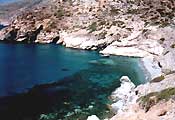 Mourou
Mourou
A pebble beach with 2 underwater caves that you can swim into.
Located near the small villages of Arkesini and Kamari, Mourou is
very popular with visitors to Amorgos.
Maltezi
A secluded sandy beach located near to Katapola port.
Agioi Saranta
A beautiful sandy beach, Agioi Saranta (40 saints) can be found
outside the port of Katapola, on the left side.
 Kalotaritisa
Kalotaritisa
A long sheltered beach with fine sand on the southern part of
Amorgos where the many fishing boats add to the feeling of
tranquility.
Ammoudi
A lovely small beach near the village of Arkesini with fine white
sand and crystal blue waters.
Kato Kambos
Near the village of Kolofana, this small picturesque gulf has a
sandy and rocky beach with a lovely little chapel right on the
waters edge.

Nikouria
Nikouria is a small uninhabited island in front of Aegiali Bay, with
regular crossings by caique during the summer from Aegiali town.
Visitors can find beautiful sandy beaches and amazing waters that
are ideal for snorkeling.
WORTH SEEING ON AMORGOS
Panagia Hozoviotissa Monastery
 This remarkable monastery is the pride of Amorgos and is one of the
finest monasteries in all Greece. Appearing "pressed" on the
cliffside, 300 meters above the sea, the monastery was built around
1017 and then renovated in 1088 on the instruction of the Byzantine
Emperor, Alexis Komninos. Visitors from around the world stand in awe
and wonder how this architectural masterpiece was built using the
primitive tools available at the time. On November 21st there is a
festival celebrating the saints day with and food and sweets offered
to visitors made by the residents of Amorgos.
This remarkable monastery is the pride of Amorgos and is one of the
finest monasteries in all Greece. Appearing "pressed" on the
cliffside, 300 meters above the sea, the monastery was built around
1017 and then renovated in 1088 on the instruction of the Byzantine
Emperor, Alexis Komninos. Visitors from around the world stand in awe
and wonder how this architectural masterpiece was built using the
primitive tools available at the time. On November 21st there is a
festival celebrating the saints day with and food and sweets offered
to visitors made by the residents of Amorgos.
The Archaeological Museum
Located in Chora and housed in a traditional old mansion, known as
Sala tou Gavra ("Hall of Gavras"). The museum contains some
interesting pieces excavated on the island including remnants of the
Minoan civilisation which existed here more than 4,000 years ago. On
the ground floor there are architectural finds from the Hellenistic,
Roman and Early Christian periods plus marbles of Cycladic culture.
